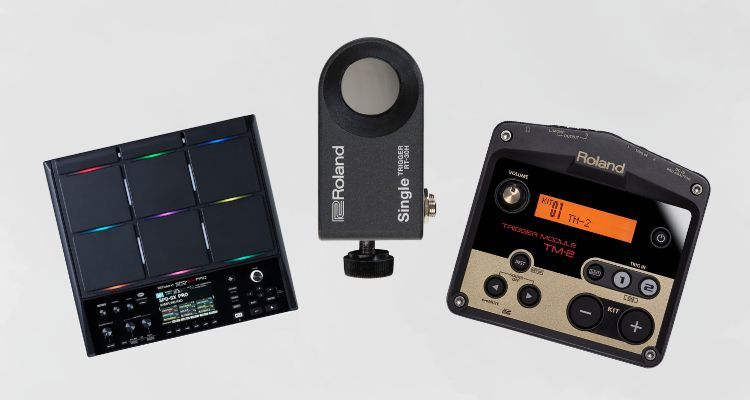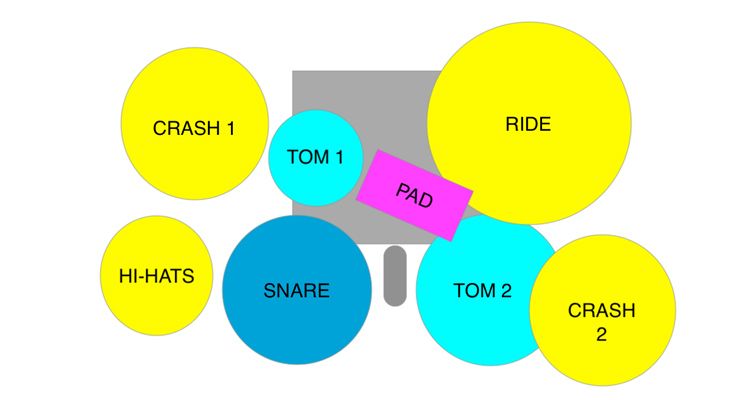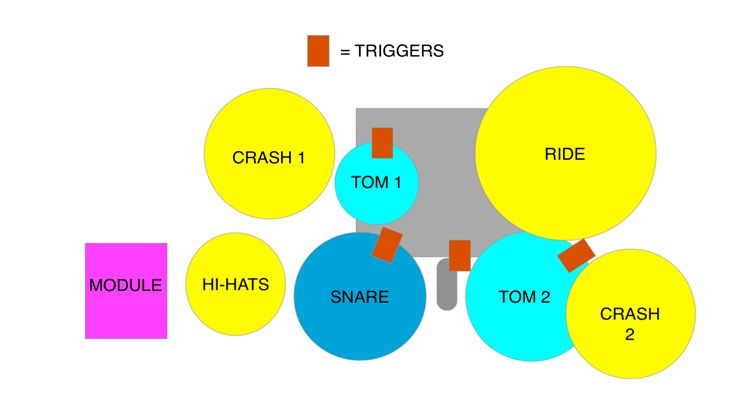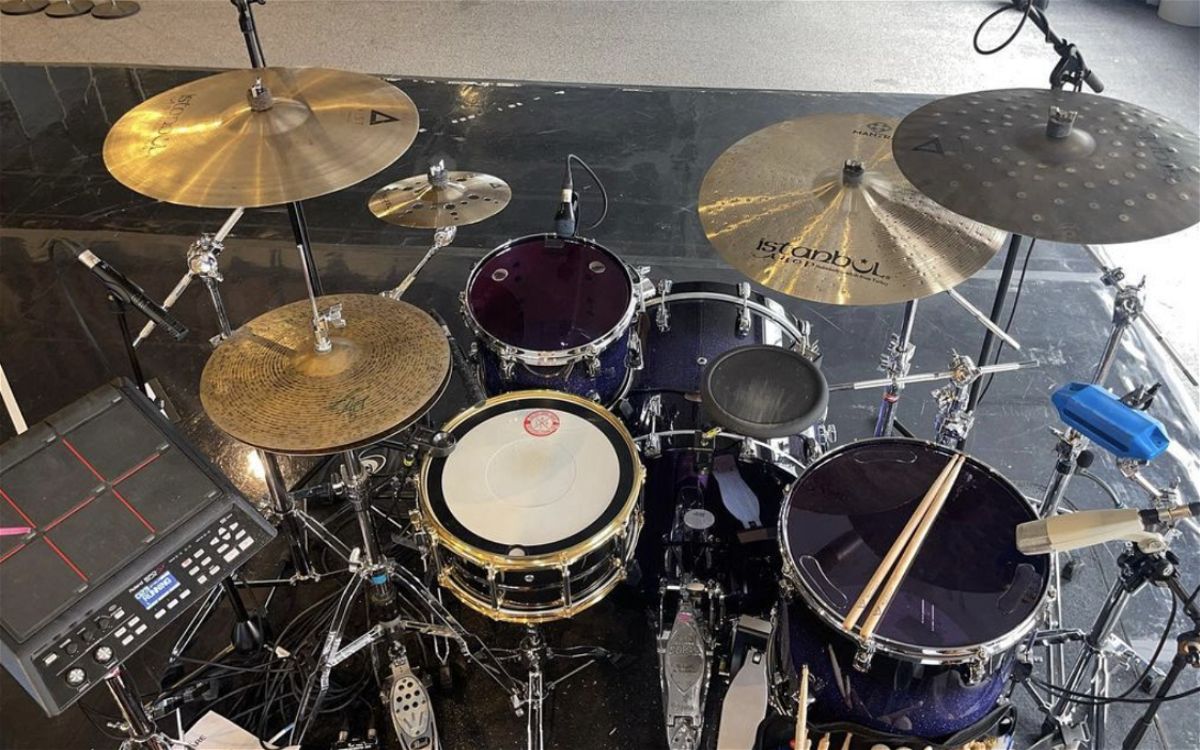Hybrid drum sets have become more and more common over the last decade. Electronic equipment has become an essential part of many live gigs, and drummers often have to play more than just the acoustic drums and cymbals in front of them.
While using a hybrid kit was mainly something that drummers did for pop and hip-hop gigs a few years ago, we’re seeing metal and rock bands need them as well.
So, it’s important to know how to create your own hybrid kit in case you ever need to use one.
This guide will show you everything you need to know. We’ll look through all the tools you’ll need, and I’ll show you different setup ideas with diagrams to reference.
Contents
What is a Hybrid Drum Kit?
A hybrid drum kit is a setup that combines electronic drum equipment with acoustic drums and cymbals. It allows you to play electronic drum sounds that you can’t play on acoustic drums, giving you a new world of sound possibilities.
Hybrid drum kits are set up so that the electronic gear is integrated into the acoustic gear. You can sit at a hybrid kit and comfortably play acoustic drums and electronic pads smoothly and interchangeably.
Not all hybrid kits look the same. Some only have a single pad that plays an electronic sound like a handclap or finger snap, while others have several pads and triggers to completely change how the acoustic drums sound.
Whether an acoustic drum kit has one electronic pad or ten, it’s still considered a hybrid setup.
Some people may refer to it as an electric acoustic drum set or a hybrid electronic drum kit.
Why Do Drummers Need Hybrid Drum Kits?
Drummers mainly need to use hybrid drum sets for live gigging purposes. Modern music has seen bands and artists incorporating a lot of electronics into their songs, and those artists always want the songs in their live shows to sound the same as their studio recordings.
When those studio recordings have digital percussion sounds that weren’t recorded by acoustic drums, a drummer can use a hybrid drum set to play those sounds at a live show.
Many drummers also love using hybrid drum kits in their personal practice spaces. It’s a modern way of drumming, and it offers a lot more playing possibilities than simply having acoustic drums.
Converting acoustic drums to electric drums is easier than it has ever been, so the low barrier-to-entry for creating a hybrid setup has also added to more drummers giving it a go.
What You Need for Hybrid Drumming

Electronic Sample Pad
Electronic sampling pads are the most used pieces of gear for creating a hybrid drum kit setup. They’re easy to integrate, as they’re full-on instruments by themselves.
A sampling pad typically has six to twelve pads on the surface, and you can assign various sounds to each one. Most pads also have a wide range of features that extend their playability and make them more of an asset to a hybrid setup.
The industry-standard sampling pad over the last decade has been the Roland SPD-SX, but Roland recently brought out the SPD-SX Pro which is better in every way, and is the best electronic pad on the market.
Here are a few other great options:
- Alesis Strike MultiPad Percussion Pad
- Yamaha DTX-MULTI 12 Electronic Percussion Pad
- Nord Modeling Percussion Synthesizer Multi-Pad
The sampling aspect of all these pads means that you can load in or create your own sounds. There are a few percussion pads available that only have stock electronic percussion sounds with no expandability options.
Those can still be used to make a hybrid drum kit, but they’re quite limited.
Electronic Drum Pads
Drum pads are single rubber or mesh pads that you can place around your kit. These pads are mostly the same ones that get used for drums on electronic drum sets. However, you get a few single pads that look more like mini versions of sampling pads.
These pads are excellent for placing comfortably within your drum kit setup so that they’re easy to play.
While sampling and percussion pads are quite big and bulky, placing a single pad is the same as setting up a woodblock or cowbell somewhere.
If you use single-zone pads, you’ll only be able to play one sound at a time from them. Multi-zone pads will allow you to play various sounds depending on where you hit them.
These pads don’t produce sounds on their own, so you must connect them to an electronic module or sampling pad to assign sounds to them.
Triggers
Triggers are small pieces of equipment that attach to your drums. Some of them clip onto the rims, while others have a sticky part that attaches to the drumheads.
The point of triggers is to change the sound of your acoustic drum shells. For example, you’ll attach a trigger to your snare drum, and then you can alter the sound that comes out whenever you strike the snare drum.
You’ll get a combination of the snare drum sound, along with whatever sound that you’ve assigned to that trigger.
Triggers affect your setup a lot more than single pads and sampling pads do, as they completely change what you hear when you play.
Here are popular triggers that drummers use:
Drum Trigger Module
Triggers also don’t work on their own. You need to connect them to an electronic brain, and one of the easiest options to use is a trigger module.
Drum trigger modules are small, and many of them are very affordable, and most of them will give you ten to twenty electronic sounds that you can assign to the triggers.
With most of them, you can also import your own sounds, which is incredibly useful when creating a personalized hybrid drum set setup.
Here are a few popular drum trigger modules:
Electronic Drum Module
The final option to consider is an electronic drum module. If you already have an electronic drum set, you can set its module up next to your acoustic kit and run pads or triggers through it.
This option is fantastic for drummers who don’t want to spend extra cash on buying new things, as you can also use the drum pads from your electronic set. You’ll be combining your two kits together to create hybrid acoustic electronic drums.
Hybrid Drum Kit Setup Ideas
Percussion Pad Setup
If you want to set up a percussion or sampling pad at your kit, you’ll need to get a stand to mount it on. Most of them don’t get sold with stands, so you need to buy them separately.
Setting this up is very easy, as you just need to place the percussion pad next to your kit. You need to make sure that it’s in a comfortable spot that is both comfortable to reach with your sticks and easy to use the interface with your hands.
There are two main places where drummers like to put these pads. The first one is to the left of the hi-hats. It will sit in the same spot as where an electronic drum module sits on an electronic kit. You’ll then mostly play the pads with your left hand.

The second popular positioning is to have the percussion pad sit between the rack tom and floor tom. This makes it more comfortable to play with your dominant hand, but it only works in setups that don’t have a middle rack tom.

Drum Trigger Setup
Drum triggers require the use of a trigger module, sampling pad, or electronic drum kit module. So, you need to decide where you’re going to place that.
If you’re using a sampling pad, then you can use the same setup ideas as above. If you’re simply using a trigger module, then it’s best to place it to the left of the hi-hats. That will keep it out of the way, but it will still be easy to access.
When it comes to the triggers themselves, it’s best to put one on the bass drum and one on the snare drum. If you want to use more triggers, then you can put them on the toms.
You’ll then need to run cables from those triggers to the drum module or sampling pad, so make sure to place them neatly around your drum kit.

Combined Electronic Pads and Acoustic Drums Setup
Electronic drum pads are fantastic in the fact that you can place them anywhere. They’re usually sized between 6” and 10”, so they’re incredibly easy to fit in small spots around your kit.
The diagram below is just one example of how you can place drum pads, but you should play around and see what feels comfortable for you.
Remember that these pads will feel like percussive additions to your kit, so they need to be put in places that feel natural to play. They should be as easily reachable as all your drums and cymbals.
You’ll then need to connect the pads to a drum module.

How Do You Convert Acoustic Drums to Electric Drums?
The best way to turn acoustic drums into electronic drums is to use triggers. If you place triggers on each drum in your setup, you’ll be able to control the sounds through the drum module that you connect them to.
However, you’ll still get the loud acoustic drum sound. If you want to get the volume benefits of an electronic drum kit, then you should equip your acoustic drum shells with low-volume drumheads.
The low-volume drumheads will reduce the volume drastically, and then you’ll be able to play electronic sounds through the drum module.
Unfortunately, trigger technology doesn’t work too well on cymbals, so you’ll need to swap your acoustic cymbals with cymbal pads. You can then connect those to the drum module as well.
Conclusion
Another thing to remember with hybrid drum kits is that the quality of your electronic sounds will depend on the quality of the module or percussion pad that you’re using.
If you use an inexpensive drum module, the electronic sounds won’t be as responsive as the acoustic sounds from your kit. That’s why it’s typically better to use a popular percussion pad or a trigger module that was built for live performances.
You can play some incredible things with a hybrid drum kit, and hybrid drumming has given drummers more control and responsibility in band settings. It’s worth learning how to use a hybrid kit, as it will make you more hireable as a drummer.









